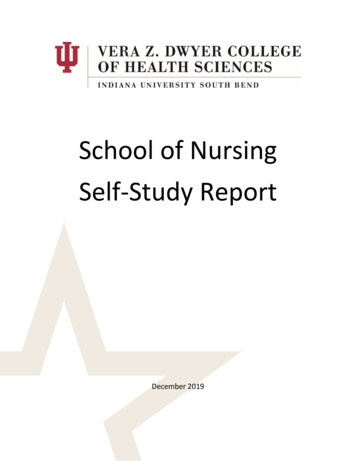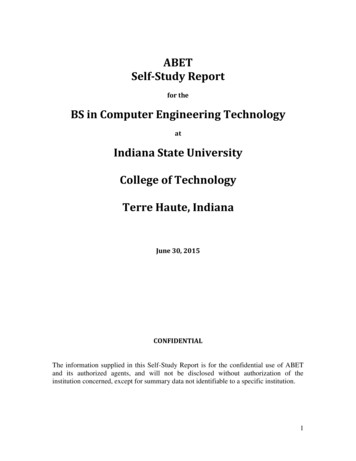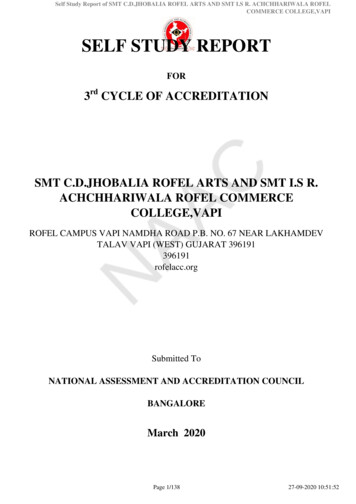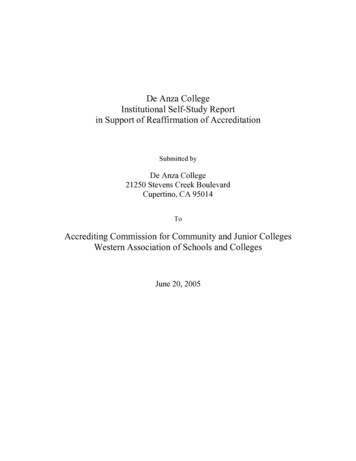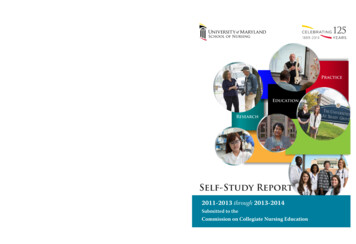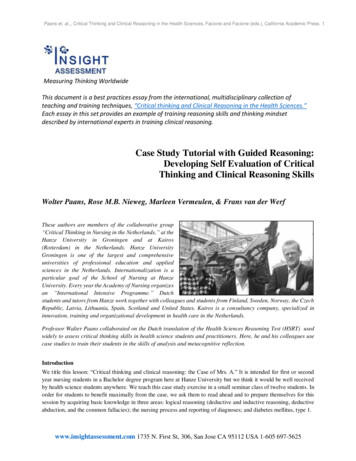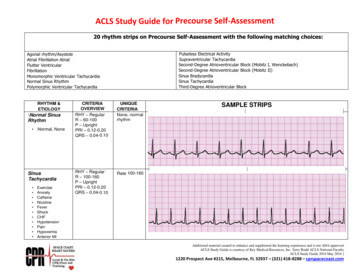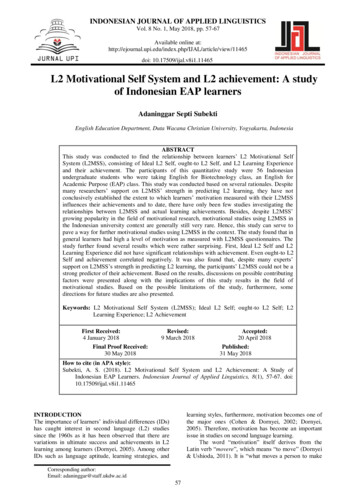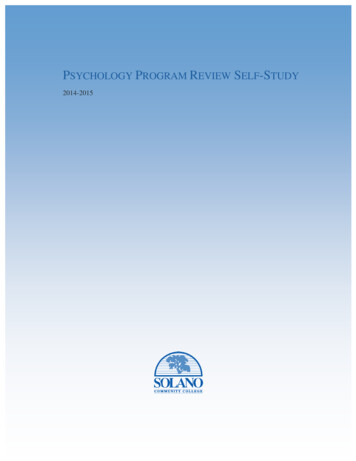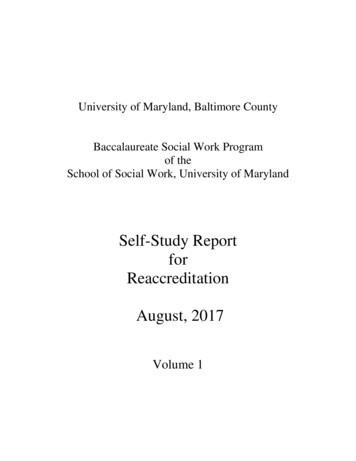
Transcription
University of Maryland, Baltimore CountyBaccalaureate Social Work Programof theSchool of Social Work, University of MarylandSelf-Study ReportforReaccreditationAugust, 2017Volume 1
ContentsPROGRAM MISSION AND GOALSEDUCATIONAL POLICY 1.0—PROGRAM MISSION AND GOALS . 3Accreditation Standard 1.0—Program Mission and Goals . 3EXPLICIT CURRICULUMEDUCATIONAL POLICY 2.0 – GENERALIST PRACTICE . 9EDUCATIONAL POLICY 2.2—SIGNATURE PEDAGOGY:FIELD EDUCATION . 53Accreditation Standard 2.2—Field Education . 53IMPLICIT CURRICULUMEDUCATIONAL POLICY 3.0—DIVERSITY . 84Accreditation Standard 3.0—Diversity. 84EDUCATIONAL POLICY 3.1—STUDENT DEVELOPMENT . 104Accreditation Standard 3.1—Student Development: Admissions, Advisement,Retention, and Termination; and Student Participation . 104EDUCATIONAL POLICY 3.2—FACULTY . 130Accreditation Standard 3.2—Faculty. 130EDUCATIONAL POLICY 3.3—ADMINISTRATIVE AND GOVERNANCESTRUCTURE . 142Accreditation Standard 3.3—Administrative and Governance Structure . 142EDUCATIONAL POLICY 3.4—RESOURCES . 155Accreditation Standard 3.4—Resources . 155ASSESSMENTEDUCATIONAL POLICY 4.0—ASSESSMENT OF STUDENT LEARNINGOUTCOMES. 176Accreditation Standard 4.0—Assessment . 182
1INTRODUCTION TO UNIVERSITY OF MARYLAND,BALTIMORE COUNTYThe University of Maryland, Baltimore County (UMBC), was founded in 1966 and is a midsizepublic research university (http://umbc.edu/). Under the Carnegie Classification of Institutions ofHigher Education, UMBC is termed a doctoral university with higher research activity. It is amember of the University System of Maryland (USM), an 11-campus organization thatconstitutes one of the largest academic and research institutions in the nation. The USM isaccredited by the Middle States Commission on Higher Education, recognized by the Council forHigher Education Accreditation and contributes significantly to the economic and culturalvitality of the state and the mid-Atlantic region. UMBC’s most recent accreditation wasconducted in academic year 2016–17.The fall 2016 enrollment at UMBC was 13,839, including 11,243 undergraduate students (84.8%of whom were full-time) and 2,596 graduate students (45.7% of whom were full-time). Thestudent body reflects the diversity of Maryland, from which 80% reside. Approximately 16% ofthe student body is African American, 18% are Asian, and 6% are Hispanic or Native American.It is estimated that 40% of each year’s incoming undergraduates are transfer students, originatingprimarily from Maryland’s community colleges.With 533 full-time instructional and 268 part-time faculty members, UMBC has recruited 58new faculty members to tenure-track and tenured positions in the last 4 years. The facultysupport 55 majors and 35 minors as well as 24 certificate programs spanning visual andpreforming arts to information technology and preprofessional studies.The Baccalaureate Social Work Program has its origins in a unique and highly successfulcooperative effort of two campuses of the university system. The program was started inSeptember 1969 through the combined efforts of the School of Social Work, University ofMaryland, Baltimore (UMB), and the UMBC campuses (http://www.ssw.umaryland.edu/). It wasintroduced on the UMBC campus because as a professional schools campus, UMB does not offerundergraduate liberal arts courses. The MSW and PhD programs of the School of Social Workare located with the professional schools on the UMB campus in downtown Baltimore, 8 miles
2from UMBC. The Baccalaureate Social Work Program was first accredited by the Council onSocial Work Education in l974 and has maintained its accreditation continuously to the presenttime.A particularly exciting and innovative development in the history of the UMBC BaccalaureateSocial Work Program occurred in 2000 with the establishment of a satellite program at theUniversities at Shady Grove (USG) in Montgomery County, Maryland, a suburb of Washington,DC. Currently, USG offers more than 80 undergraduate and graduate degree programs from nineMaryland public universities (https://www.shadygrove.umd.edu/about-usg). Each universityprovides its most in-demand academic programs and awards its own degrees. USG, in turn,provides centralized, on-site student, academic, and administrative services in the areas ofadmissions, financial aid, technology, student support, and campus life. This integrated approachallows USG to offer accessible pathways to more than 80 upper-level undergraduate, graduate,and professional degree and certificate programs.Students admitted to the UMBC Baccalaureate Social Work Program at USG will completeapproximately 2 years of full-time study prior to enrollment. Once enrolled in the BaccalaureateSocial Work Program, they will complete the remainder of their upper-level credits along withall the core social work curriculum. Students may transfer a maximum of 60 credits from acommunity college and 90 credits from a 4-year school to UMBC. All social work majors on theUSG campus take the same courses, including field instruction and a year-long field placement,as their counterparts on the UMBC campus and meet the same academic requirements forgraduation with a degree in social work as main campus students.
3EDUCATIONAL POLICY 1.0—PROGRAM MISSION AND GOALSThe mission and goals of each social work program address the profession’s purpose, aregrounded in core professional values, and are informed by program context.1.1:ValuesService, social justice, the dignity and worth of the person, the importance of humanrelationships, integrity, competence, human rights, and scientific inquiry are among thecore values of social work. These values underpin the explicit and implicit curriculum andframe the profession’s commitment to respect for all people and the quest for social andeconomic justice.1.2:Program ContextContext encompasses the mission of the institution in which the program is located and theneeds and opportunities associated with the setting and program options. Programs arefurther influenced by their practice communities, which are informed by their historical,political, economic, environmental, social, cultural, demographic, local, regional, andglobal contexts and by the ways they elect to engage these factors. Additional factorsinclude new knowledge, technology, and ideas that may have a bearing on contemporaryand future social work education, practice, and research.ACCREDITATION STANDARD 1.0: PROGRAM MISSION AND GOALSThe social work program’s mission and goals reflect the profession’s purpose and valuesand the program’s context.1.0.1: The program submits its mission statement and explains how it is consistent with theprofession’s purpose and values.The Baccalaureate Social Work Program’s mission statement:Through excellence in teaching, research and service, the Baccalaureate Social Work Program,University of Maryland, School of Social Work, prepares students for generalist social work
4practice inclusive of diverse individuals, families, groups, and communities across a widelyranging geographic region. The program is committed to the core social work values and ethicsof: belief in the dignity and worth of all individuals; a commitment to social, economic andenvironmental justice; and practicing with integrity and competence.The mission statement underscores the goal of educating students for beginning-level generalistsocial work practice with individuals, families, groups, organizations, and communities. Thus,the mission reflects the premise that a liberal arts perspective in professional education enrichesthe understanding of the person-in-environment context of generalist social work practice.Students in the baccalaureate program learn a range of generalist skills and interventiontechniques to enable them to intervene directly and effectively with client systems of all sizesand to address social problems facing society in general.A major expectation of the Baccalaureate Social Work Program is that its students willunderstand and embrace the social work values as expressed specifically in the NationalAssociation of Social Workers’ Code of Ethics. This includes, but is not limited to, lifelongscholarship, commitment to cultural diversity and social justice, and self-reflective and selfdirected practice. The mission statement, which is the same for the programs on University ofMaryland, Baltimore County (UMBC), and Universities at Shady Grove (USG) campuses, isprominently displayed on all program publications—including the Student dent-Guide-2017-18-ALL.pdf) and FieldEducation Manual nual-for-Website-2.pdf)published each year—and also appears on the program’s website:http://www.umbc.edu/socialwork.1.0.2: The program explains how its mission is consistent with the institutional mission andthe program’s context across all program options.The mission statement of UMBC, which applies to the UMBC programs at USG, espouses acommitment to academic excellence and cultural diversity. With respect to the BaccalaureateSocial Work Program, UMBC’s emphasis on the liberal arts is evident in the general education
5requirements, as is its recognition of the importance of collaborative and interdisciplinaryinitiatives. The university highlights the important role it plays in enhancing the quality of life inthe region through its educational and cultural programs and its research and technology initiatives.The following are excerpts from the UMBC mission statement that are particularly relevant forthe social work program and its program goals and objectives (the UMBC mission statement canbe found versity Description/missionStatement.html).UMBC is a dynamic public research university integrating teaching, research and service tobenefit the citizens of Maryland. As an Honors University, the campus offers academicallytalented students a strong undergraduate liberal arts foundation that prepares them forgraduate and professional study, entry into the workforce, and community service andleadership. . . . UMBC is dedicated to cultural and ethnic diversity, social responsibility andlifelong learning.At the core of UMBC is a steadfast commitment to engage leading research faculty in the liberalarts and sciences education of its undergraduates—guiding students in critical thinking, creativeproblem solving, experiential learning, and the development of conceptual skills. UMBC activelypromotes interaction between students and faculty, undergraduate participation in researchprojects, and service to the community. Members of UMBC’s faculty are selected and promotedon the basis of their scholarly and creative productivity, successful teaching, and service to theprofession and the public.UMBC is committed to diversity at all levels and seeks to create a campus community rich inintellectual, cultural, and ethnic diversity. The University is committed to the success of each ofits students and seeks to attract well-qualified students through special scholarship initiatives inthe humanities, arts, and public affairs and through the nationally recognized Meyerhoff ScholarsProgram for talented high school graduates in science and engineering. UMBC expects to
6continue to attract private and public funding to facilitate the success of minority students in thesciences and engineering. Its emphasis on quality, high achievement, and the integration ofresearch, teaching and learning, and civic engagement is designed to prepare all students forsuccess in graduate and professional education as well as success in the workplace.The Baccalaureate Social Work Program, located on the UMBC and USG campuses, is anintegral part of the School of Social Work, University of Maryland, Baltimore (UMB). Themission statement of the School of Social Work applies to each of its programs—baccalaureate,master’s, and doctoral—as indicated by the following:Our mission at the University of Maryland, School of Social Work is to develop practitioners,leaders and scholars to advance the well-being of populations and communities and to promotesocial justice. As national leaders, we create and use knowledge for education, serviceinnovation, and policy development.The integration of the mission statements can be seen in the strategic plans for UMBC(http://planning.umbc.edu/) and the School of Social rategic-plan/). Both plans document thecollaborative and inclusive processes central to the culture of UMBC and the School of SocialWork. Further, the extensive strategic efforts used to communicate and consult with facultymembers of the Baccalaureate Social Work Program about the objectives and plans speak to therole of the program in both institutions.1.0.3: The program identifies its goals and demonstrates how they are derived from theprogram’s mission.The Baccalaureate Social Work Program faculty has identified three overarching goals thatguide all of its endeavors and stem from the program’s mission statement. These goals are to:1. Provide a learning environment which supports students from diverse backgrounds indeveloping the competencies necessary for generalist practice.
72. Create and disseminate knowledge through scholarship that is integrated withteaching and service and that advances social work practice and social welfare policy.3. Foster a commitment among students to continuing education,enhancing competence in practice, maintaining high ethical standards, and seekingopportunities for renewal and advancement within the profession.Figure 1.1 The Integration of the Mission Statement and Goals with the ProgramProvide a learning environmentwhich supports students fromdiverse backgrounds indeveloping the competenciesnecessary for generalist practice.MissionsUMBCSSWCurriculumSWProgramCreate and disseminateknowledge through scholarshipthat is integrated with teachingand service and that advancessocial work practice and socialwelfare policy.Foster a commitment amongstudents to continuing education,enhancing competence inpractice, maintaining high ethicalstandards, and seekingopportunities for renewal andadvancement within theprofession.FacultyFieldEducationAs displayed in Figure 1.1, the goals are derived from the program’s missionand are implemented through curriculum design; faculty assignments, workload, andscholarship; ongoing evaluation of the program; and ongoing program activities, events, andprojects. In curriculum design, all social work courses include objectives, assignments, andreadings that implement the program’s educational goals, with special emphasis on salienttopics such as practice and policy competencies, professional values, ethics, and historicaltraditions of the social work profession; human diversity and the nature of oppression and
8discrimination; a bio-psycho-social, strengths-based perspective; application of theory andevidence-based research to practice; and advancement of human rights and social, economic,and environmental justice.To ensure complete integration of the program’s goals in field education on both the UMBCand USG campuses, each field instructor and must identify how a student will accomplish theprogram’s nine competencies and subsequent behaviors in her or his individual field setting.The field education learning agreement and evaluation is explicitly based on the application ofcompetencies in practice. Thus, students’ performance in field education is evaluated in thelight of their ability to engage in and develop competencies with individuals, families, groups,organizations, and communities. To ensure understanding and implementation of the program’seducational goals and competencies, field instructors are given a comprehensive orientationbefore the field placement begins. They receive a copy of the Field Education eld-Manual-for-Website-2.pdf)—which includes a description of the program’s mission, goals, and competencies for readyreference—and they are provided with ongoing clarification and support by their faculty fieldliaison.
9EXPLICIT CURRICULUMThis section addresses the following Educational Policies related to the explicit curriculum:Generalist Practice and the Signature Pedagogy, Field Education.EDUCATIONAL POLICY 2.0—GENERALIST PRACTICEGeneralist practice is grounded in the liberal arts and the person-in-environmentframework. To promote human and social well-being, generalist practitioners use a rangeof prevention and intervention methods in their practice with diverse individuals, families,groups, organizations, and communities based on scientific inquiry and best practices. Thegeneralist practitioner identifies with the social work profession and applies ethicalprinciples and critical thinking in practice at the micro, mezzo, and macro levels.Generalist practitioners engage diversity in their practice and advocate for human rightsand social, and economic and environmental justice. They recognize, support, and build onthe strengths and resiliency of all human beings. They engage in research-informedpractice and are proactive in responding to the impact of context on professional practice.ACCREDITATION STANDARD B2.0: Generalist PracticeB2.0.1: The program explains how its mission and goals are consistent with generalist practiceas defined in EP 2.0.The Baccalaureate Social Work Program on the University of Maryland, Baltimore County(UMBC), and the Universities at Shady Grove (USG) campuses prepare students for generalistsocial work practice with diverse individuals, families, groups, organizations, and communities.An important feature of the generalist model of practice is the focus on the person-inenvironment framework. Students apply ethical principles and respect diversity in their practice;they learn a range of methods for engagement, assessment, prevention, and intervention that aregrounded in scientific inquiry and are evidenced based. Students acknowledge and supportclients’ strengths and resiliency, advocating for human rights and social, economic, andenvironmental justice at the micro, mezzo, and macro levels.
10The program defines generalist practice as follows:Generalist practice involves a comprehensive, multi-system approach to assessmentand intervention that draws on a variety of theoretical models and perspectives and isrelevant in diverse practice settings. Generalist practice maintains a simultaneousfocus on interactions between persons and systems in the wider environment. Itcapitalizes on and cultivates resources within individual clients and within theirwider social environment.This definition appears in the Student Guide uide-2017-18-ALL.pdf), which is provided to all social work majors, and the Field EducationManual nual-for-Website-2.pdf), which isdistributed to all field
The University of Maryland, Baltimore County (UMBC), was founded in 1966 and is a midsize . The MSW and PhD programs of the School of Social Work . The mission statement of UMBC, which applies to the UMBC programs at USG, espouses a commitment to academic excellence
